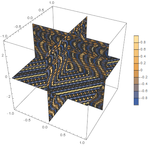SOCR News DCMB ToolsTechSeminar 2020
Contents
SOCR News & Events: Spacekime Analytics
The DCMB Tools and Technology Seminar Series highlights tools and nascent technologies that are under development or in current use and are of interest to UM R&D community. These seminars are streamed live, using BlueJeans Events, and are also archived and made available for future viewing via video streaming via the below video archive which links to the DCMB YouTube Chanel.
Logistics
- DCMB Tools and Technology Seminar Series
- Date/Times: Thursday, October 8, 2020, 12 Noon (ET)
- Place: 2036 Palmer Commons, Zoom Event
- Title: Spacekime Analytics
- Presenter: Ivo Dinov, joint work with Milen V. Velev (Burgas University)
- Abstract: The large amounts of heterogeneous information, which is immersed in all human experiences, present important challenges of managing, modeling, analyzing, interpreting, and visualizing complex information. There are substantial opportunities to develop, validate, and productize novel mathematical techniques, advanced statistical computing algorithms, transdisciplinary tools, and effective artificial intelligence apps.
- Spacekime analytics is a new technique for modeling high-dimensional longitudinal data. This approach relies on extending the notions of time, events, particles, and wavefunctions to complex-time (kime), complex-events (kevents), data and inference-functions. We will illustrate how the kime-magnitude (longitudinal time order) and kime-direction (phase) affect the subsequent predictive analytics and the induced scientific inference. The mathematical foundation of spacekime calculus reveals various statistical implications including inferential uncertainty and a Bayesian formulation of spacekime analytics. Complexifying time allows the lifting of all commonly observed processes from the classical 4D Minkowski spacetime to a 5D spacetime manifold, where a number of interesting mathematical problems arise.
- Direct data science applications of spacekime analytics will be demonstrated using simulated data, clinical observations (e.g., fMRI, UK Biobank), and environmental air quality data.
- Slidedeck: Presentation Slides
Objectives
- Offer a number of "open-science" resources for data science and predictive health analytics
- Present the Spacekime analytical approach for longitudinal high-dimensional, and heterogeneous biomedical datasets and health case-studies
- Provide hands-on experience with using R-based spacekime tools and web-services. Attendees are encouraged to bring their R-enabled laptops and their own data
- Present some open math problems, computational algorithmic barriers, and data science challenges.
Discussion Topics
- Data Science & Predictive Analytics (DSPA) Skills (10-min)
- Overview of SOCR capabilities, resources, and expertise (10-min)
- Hands-on Practice, Try-It-Now, apply to new data (20-min)
- Suggestions, comments, questions, critiques, etc. (10-min)
- Participants should bring laptops, and datasets, to try some of the hands-on resources before, during, and after the training workshop
- URL: https://wiki.socr.umich.edu/index.php/SOCR_News_DCMB_ToolsTechSeminar_2020.
Background
- SOCR News & Events
- SOCR Global Users
- SOCR Navigators
- SOCR Datasets and Challenging Case-studies
- Electronic Textbooks:
Demos
- General SOCR Webapps
- SOCR BrainViewer
- Motion Charts webapp (try it with your own high-dimensional longitudinal data, e.g., Ozone Data)
- Hands-on interactive visualization of extremely high-dimensional data (learning module and webapp)
- Predicting Hospitalization-based Pressure Injuries (webapp)
- Virtual Hospital and Simulated Patient EHR Data (webapp)
References
- This work is sponsored in part by NIH Grants P30 DK089503, P20 NR015331, R01CA233487, and R01MH121079, as well as, NSF Grants 1916425, 1734853 and 1636840.
- Dinov, ID and Velev, MV (2021) Data Science: Time Complexity, Inferential Uncertainty, and Spacekime Analytics, De Gruyter (STEM Series), Berlin/Boston, ISBN 9783110697803 / 3110697807.
- SOCR Home page: http://www.socr.umich.edu
Translate this page:

